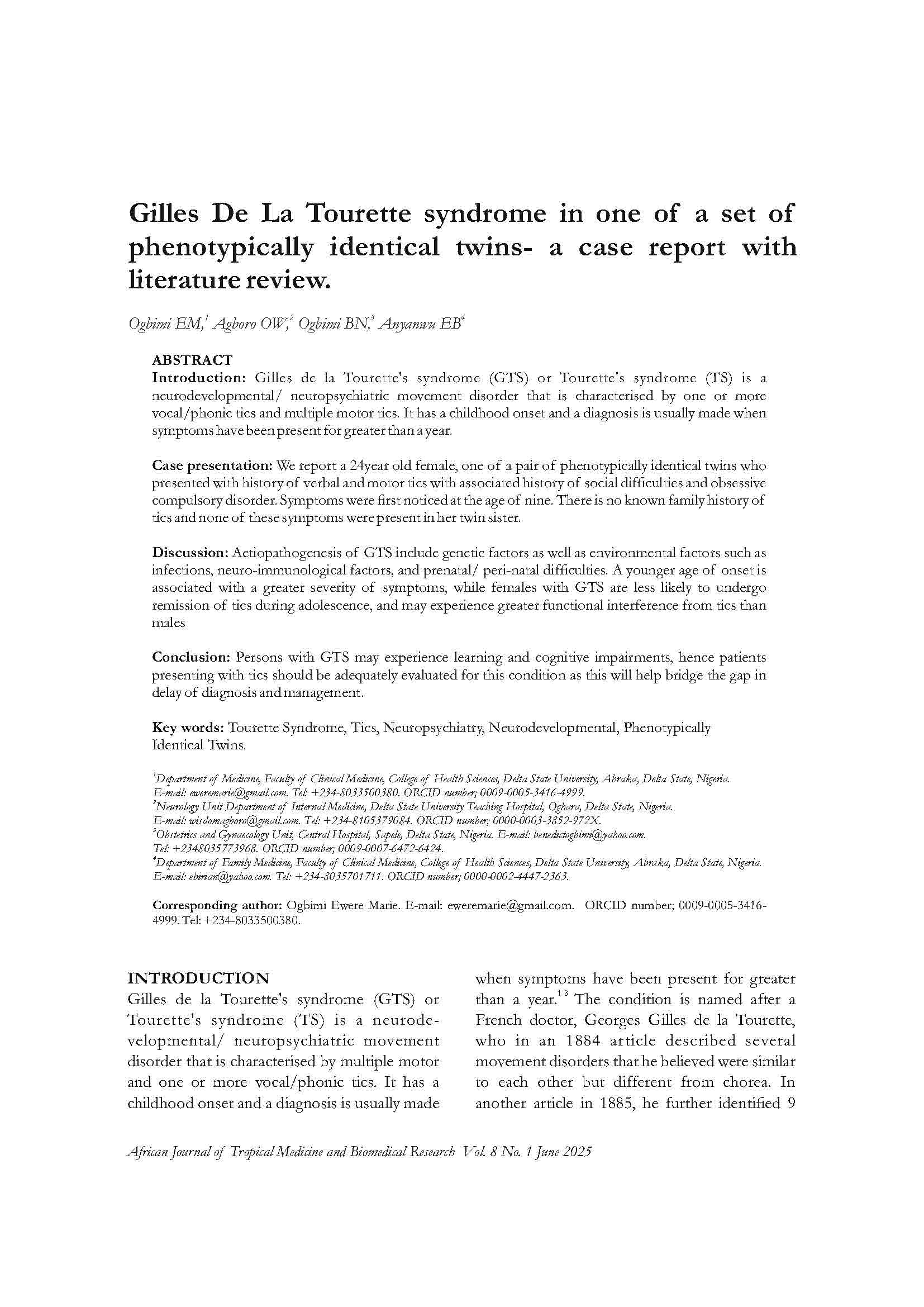Gilles De La Tourette Syndrome in One of a Set of Phenotypically Identical Twins
A Case Report with Literature Review
DOI:
https://doi.org/10.4314/ajtmbr.v8i1.11Keywords:
Tourette's Syndrome, Tics, Neuropsychiatry, Neurodevelopmental,, Phenotypically Identical TwinsAbstract
Introduction: Gilles de la Tourette’s syndrome (GTS), or Tourette’s syndrome (TS), is a neurodevelopmental/neuropsychiatric movement disorder characterized by multiple motor and one or more vocal/phonic tics. It has a childhood onset, and a diagnosis is usually made when symptoms have persisted for more than a year.
Case Presentation: A 24-year-old female, one of a pair of phenotypically identical twins, presented with verbal and motor tics, social difficulties, and obsessive-compulsive disorder. Symptoms first appeared at age nine. There was no family history of tics, and her twin sister exhibited no symptoms.
Discussion: The aetiopathogenesis of GTS includes genetic and environmental factors such as infections, neuro-immunological factors, and perinatal complications. Earlier onset is associated with more severe symptoms. Females with GTS are less likely to experience remission during adolescence and may have greater functional impairment.
Conclusion: Individuals with GTS may experience learning and cognitive impairments. Clinicians should evaluate patients presenting with tics to ensure early diagnosis and appropriate management to reduce psychosocial impact.
References
Prakash J, Singh P, Bhat PS, Srivastava K, Gupta V. A case of Gilles de la Tourette's syndrome. Indian Psychiatry J. 2015;24(2):192–4.
Cath DC, Hedderly T, Ludolph AG, Stern JS, Murphy T, Hartmann A, et al. European clinical guidelines for Tourette syndrome and other tic disorders: Part I—Assessment. Eur Child Adolesc Psychiatry. 2011;20(4):155–171.
Robertson MM. The Gilles de la Tourette syndrome: the current status. Arch Dis Child Educ Pract Ed. 2012;97(5):166–175.
Lajonchere C, Nortz M, Finger S. Gilles de la Tourette and the discovery of Tourette syndrome: includes translation of his 1884 article. Arch Neurol. 1996;53(6):567–574.
Ganos C, Sarva H, Kurvits L, Gilbert DL, Hartmann A, Worbe Y, et al. Clinical practice patterns in tic disorders among Movement Disorder Society members. Tremor Other Hyperkinet Mov (N Y). 2021;11:43.
Cavanna AE, Black KJ, Hallett M, Voon V. Neurobiology of the premonitory urge in Tourette’s syndrome: pathophysiology and treatment implications. J Neuropsychiatry Clin Neurosci. 2017;29(2):95–104.
Jung J, Jackson SR, Parkinson A, Jackson GM. Cognitive control over motor output in Tourette syndrome. Neurosci Biobehav Rev. 2013;37(6):1016–1025.
Szejko N, Robinson S, Hartmann A, Ganos C, Debes NM, Skov L, et al. European clinical guidelines for Tourette syndrome and other tic disorders—Version 2.0, Part I: Assessment. Eur Child Adolesc Psychiatry. 2022;31(3):383–402.
Knight T, Steeves T, Day L, Lowerison M, Jette N, Pringsheim T. Prevalence of tic disorders: a systematic review and meta-analysis. Pediatr Neurol. 2012;47(2):77–90.
Levine JLS, Szejko N, Bloch MH. Meta-analysis: Adulthood prevalence of Tourette syndrome. Prog Neuropsychopharmacol Biol Psychiatry. 2019;95:109675.
Scharf JM, Miller LL, Gauvin CA, Alabiso J, Mathews CA, Ben-Shlomo Y. Population prevalence of Tourette syndrome: a systematic review and meta-analysis. Mov Disord. 2015;30(2):221–228.
Mol Debes NM, Hjalgrim H, Skov L. Limited knowledge of Tourette syndrome causes delay in diagnosis. Neuropediatrics. 2008;39(2):101–105.
Lin WD, Tsai FJ, Chou IC. Current understanding of the genetics of Tourette syndrome. Biomed J. 2022;45(2):271–279.
Paschou P. The genetic basis of Gilles de la Tourette Syndrome. Neurosci Biobehav Rev. 2013;37(6):1026–1039.
Kurlan R, Como PG, Miller B, Palumbo D, Deeley C, Andresen EM, et al. The behavioral spectrum of tic disorders: a community-based study. Neurology. 2002;59(3):414–420.
Price RA, Kidd KK, Cohen DJ, Pauls DL, Leckman JF. A twin study of Tourette syndrome. Arch Gen Psychiatry. 1985;42(8):815–820.
Eldridge R, Sweet R, Lake R, Ziegler M, Shapiro AK. Gilles de la Tourette’s syndrome: clinical, genetic, psychologic, and biochemical aspects in 21 selected families. Neurology. 1977;27(2):115–124.
Albin RL, Mink JW. Recent advances in Tourette syndrome research. Trends Neurosci. 2006;29(3):175–182.
Worbe Y, Gerardin E, Hartmann A, Valabrégue R, Chupin M, Tremblay L, et al. Distinct structural changes underpin clinical phenotypes in patients with Gilles de la Tourette syndrome. Brain. 2010;133(Pt 12):3649–3660.
Draper A, Jackson SR. Alterations in structural connectivity may contribute both to the occurrence of tics in Gilles de la Tourette syndrome and to their subsequent control. Brain. 2015;138(Pt 2):244–245.
Lichter DG, Finnegan SG. Influence of gender on Tourette syndrome beyond adolescence. Eur Psychiatry. 2015;30(2):334–340.
Chou IC, Lin HC, Lin CC, Sung FC, Kao CH. Tourette syndrome and risk of depression: a population-based cohort study in Taiwan. J Dev Behav Pediatr. 2013;34(3):181–185.
Stern JS, Burza S, Robertson MM. Gilles de la Tourette’s syndrome and its impact in the UK. Postgrad Med J. 2005;81(951):12–19.
Robertson MM. Mood disorders and Gilles de la Tourette’s syndrome: an update on prevalence, etiology, comorbidity, clinical associations, and implications. J Psychosom Res. 2006;61(3):349–358.
Leckman JF. Phenomenology of tics and natural history of tic disorders. Brain Dev. 2003;25(Suppl 1):S24–S28.
Cavanna AE, Rickards H. The psychopathological spectrum of Gilles de la Tourette syndrome. Neurosci Biobehav Rev. 2013;37(6):1008–1015.
Worbe Y, Palminteri S, Hartmann A, Vidailhet M, Lehéricy S, Pessiglione M. Reinforcement learning and Gilles de la Tourette syndrome: dissociation of clinical phenotypes and pharmacological treatments. Arch Gen Psychiatry. 2011;68(12):1257–1266.

Downloads
Published
Data Availability Statement
All data is available on request
Issue
Section
License
Copyright (c) 2025 African Journal of Tropical Medicine and Biomedical Research

This work is licensed under a Creative Commons Attribution-NonCommercial-ShareAlike 4.0 International License.
Key Terms:
- Attribution: You must give appropriate credit to the original creator.
- NonCommercial: You may not use the material for commercial purposes.
- ShareAlike: If you remix, transform, or build upon the material, you must distribute your contributions under the same license as the original.
- No additional restrictions: You may not apply legal terms or technological measures that legally restrict others from doing anything the license permits.
For full details, please review the Complete License Terms.



